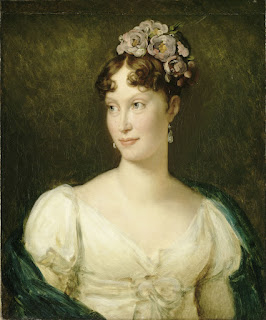Imperial ceremony in Bologna staged on birthday
 |
| Spanish artist Juan de la Corte's 17th century painting of the procession that followed the ceremony |
Considered the greatest of all the Habsburg emperors, Charles V was also King Carlos 1 of Spain. By the time he was 19, his grandfather and his father were both dead and he had become master of more parts of Europe than anyone since the emperors of ancient Rome.
He chose the day for his coronation because it was his birthday. Although he had been Holy Roman Emperor for more than ten years, Charles decided to receive his crown on his 30th birthday and elected to hold his coronation in the cathedral in Bologna because Rome was still in ruins, having been sacked by his own troops.
He was crowned by the same Pope he had held prisoner during his attack on Rome, Clement VII, who was formerly Giulio de’ Medici.
Charles V was the last emperor to be crowned by a Pope for almost 300 years, until the Emperor Napoleon forced another Pope to crown him as King of Italy in the Duomo in Milan.
Charles and Clement VII had agreed to the imperial coronation as a means of healing the political and religious conflicts that had been dividing Italy and Europe.
They were hoping for a universal peace in the Christian world that would enable countries to provide a more effective defence against Turkish aggression.
 |
| German painter Barthel Beham's portrait of Charles V, executed in 1535 |
Clement VII would have preferred Rome as the location for the coronation, but Charles had chosen Bologna because he knew that many Romans blamed him for the damage to their city which had been carried out by his troops three years earlier.
There was a lot of activity in 1529 ahead of the ceremony in Bologna. Clement VII travelled through Italy to arrive in Bologna in October 1529, where he received a splendid reception. Charles travelled by sea from Barcelona to Genoa and then made his way over land to reach Bologna in November the same year.
Pope Clement and Charles V both stayed in rooms in a palazzo in Bologna, that is known now as Palazzo d’Accursio, or Palazzo Comunale (Municipal Palace).
They agreed that on February 24, the date of the Emperor’s birthday, the coronation would take place in the Basilica di San Petronio, the biggest religious building in the city.
Two days before the coronation, Charles received the Iron Crown of Lombardy, crowning him King of Italy, from the Pope, in a chapel in the palace, which is now called the Farnese Chapel.
Ahead of the coronation ceremony, a 250-feet long bridgeway was erected to connect the palace with San Petronio.
After a long Mass in San Petronio, Charles knelt before the Pope and received the imperial golden crown, watched by aristocrats and representatives from all the Italian States.
 |
| A 17th century depiction of a scene from the coronation by Il Perugino (Luigi Scaramuccia) |
Five years earlier, on Charles’s 25th birthday, the date February 24 had acquired even more significance for him, when a French army of about 30,000 men, commanded by King Francois I of France, was besieging the town of Pavia.
To the relief of residents of Pavia, a smaller Habsburg army arrived on February 24 to relieve the garrison and launch a counter attack, firing on the French cavalry, and annihilating the rest of the French army. Francois I was himself captured and had to spend more than a year as a prisoner in Madrid.
From that date onwards, Spain was to dominate the Italian peninsula, paving the way for Charles V to be crowned King of Italy on February 22, and Holy Roman Emperor two days later.
 |
| The Basilica of San Petronio in Bologna with its unfinished marble facade |
San Petronio Basilica is the main church of Bologna, located in Piazza Maggiore in the centre of the city. It is the largest brick-built Gothic church in the world. Building work began on the church in 1390 and it was dedicated to San Petronio, who had been the Bishop of Bologna in the fifth century. The marble facade was designed by Domenico da Varignana and started in 1538 by Giacomo Ranuzzi. However, it remains unfinished to this day. This was because the construction was largely financed by the citizens of Bologna, and not by the Catholic Church, and the project became too costly to complete. The main doorway, the Porta Magna, was decorated by Jacopo della Quercia of Siena. Above this, the facade is of unadorned brick. Despite being Bologna’s most important church, San Petronio is not the city’s cathedral. This is the Duomo di San Pietro, which stands nearby on Via Indipendenza.
 |
| The Palazzo d'Accursio, where both Charles V and Pope Clement VII stayed |
Palazzo d’Accursio, also known as Palazzo Comunale or the Municipal Palace, is also in Piazza Maggiore. It began life in the 13th century as the residence of the jurist Accursius. Over time, it was expanded and attached to adjacent buildings to house civic offices. In 1336 it became the seat of the Anziani - Elders - the highest magistrates of the city, and then it became the city's seat of government. In the 15th century it was refurbished under the designs of the architect Fioravante Fioravanti, who added the clock tower, Torre d'Accursio. The bell in the tower was installed by Gaspare Nadi, a builder who became famous for the diaries he kept, which have enabled historians to learn about life in Bologna in the 15th century.
Bologna hotels from Hotels.com
Also on this day:
1607: Monteverdi’s opera. L’Orfeo, premieres in Mantua
1896: The birth of restaurateur Cesare ‘Caesar’ Cardini
1934: The birth of soprano Renata Scotto
1934: The birth of politician Bettino Craxi
1990: The death of Italian president Sandro Pertini


_-_Exterior.jpg)




